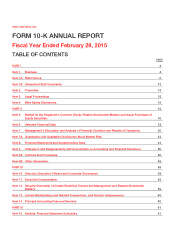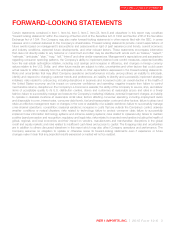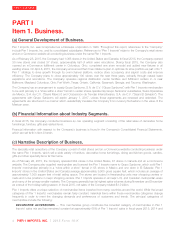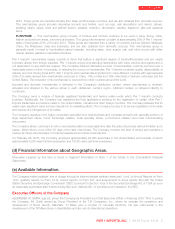Pier 1 2015 Annual Report Download - page 18
Download and view the complete annual report
Please find page 18 of the 2015 Pier 1 annual report below. You can navigate through the pages in the report by either clicking on the pages listed below, or by using the keyword search tool below to find specific information within the annual report.
ITEM 1A. RISK FACTORS.
chain, labor unrest or natural disasters could adversely affect the Company’s ability to import merchandise from certain countries.
Although the Company pays for the vast majority of its merchandise in U.S. dollars, fluctuations in foreign currency exchange
rates and the relative value of the U.S. dollar, restrictions on the convertibility of the dollar and other currencies, duties,
preferential trade agreements including general system of preferences, taxes and other charges on imports, rising labor costs
and cost of living in foreign countries, dock strikes, worker strikes, import quota systems and other restrictions sometimes placed
on foreign trade can affect the price, delivery and availability of imported merchandise as well as exports to the Company’s stores
in other countries. The inability to import merchandise from China and other countries, unavailability of adequate shipping
capacity at reasonable rates, or the imposition of significant tariffs could have a negative effect on the financial results of the
Company. Ocean carriage and freight costs contribute a substantial amount to the cost of imported merchandise. Monitoring
foreign vendors’ compliance with applicable laws and Company standards, including quality and safety standards and social
compliance issues, is more difficult than monitoring domestic vendors.
Governmental agencies have the authority to enforce trade agreements, resolve trade disputes and control market access to
goods and services. Governments may also impose trade sanctions on foreign countries that are found to violate trade
agreements or maintain laws or practices that are unjustifiable and restrict commerce. In these situations, governments may
increase duties on imports from one or more foreign countries. The Company could be negatively affected by the imposition of
trade sanctions.
The governments of the countries in which the Company does business maintain a variety of additional trade laws under which
the Company’s ability to import may be affected from time to time, including antidumping laws, countervailing duty laws,
safeguard laws, and laws designed to protect intellectual property rights. Although the Company may not be directly involved in a
particular trade dispute under any of these laws, its ability to import, or the terms and conditions under which it can continue to
import, may be affected by the outcome of such disputes.
The Company imports merchandise from countries around the world and as a result may be affected from time to time by
antidumping petitions alleging that foreign manufacturers are selling their own products at prices that are less than the prices that
they charge in their home country market or in third country markets or at less than their cost of production. Such petitions, if
successful, could significantly increase import duties on those products. In that event, the Company might decide to pay the
increased duties, thereby reducing gross profits or increasing the price to consumers of the affected products. Alternatively, the
Company might decide to source the product or a similar product from a different country not subject to increased duties or else
discontinue the importation and sale of the product.
Dispute resolution processes in recent years have been utilized to resolve disputes regarding market access between the
European Union, China, the United States and other countries. In some instances, these trade disputes can lead to threats by
countries of sanctions against each other, which can include import prohibitions and increased duty rates on imported items. The
Company considers any agreement that reduces tariff and non-tariff barriers in international trade to be beneficial to its business.
Any type of sanction on imports is likely to increase the Company’s import costs or limit the availability of merchandise purchased
from sanctioned countries. In that case, the Company may be required to seek similar merchandise from other countries on
terms that could be materially less favorable.
Risks Relating to Liquidity
Insufficient cash flows from operations could result in the substantial utilization of the
Company’s secured revolving credit facility or similar financing, which may limit the
Company’s ability to conduct certain activities.
The Company maintains a secured revolving credit facility to enable it to issue merchandise and special purpose standby letters
of credit as well as to fund working capital requirements. Borrowings under the secured revolving credit facility are subject to a
borrowing base calculation consisting of a percentage of certain eligible assets of the Company and are subject to advance rates
and commercially reasonable reserves. Substantial utilization of the available borrowing base will result in various restrictions on
the Company, including restrictions on the ability of the Company to repurchase its common stock or pay dividends and an
increase in the lender’s control over the Company’s cash accounts. See Note 4 of the Notes to Consolidated Financial
Statements for additional discussion regarding the Company’s secured revolving credit facility and term loan facility. The
Company entered into the Term Loan Facility on April 30, 2014. The proceeds of borrowing under the facility were used for
general corporate purposes, including working capital needs, capital expenditures, and share repurchases and dividends
permitted under the Term Loan Facility. Those borrowings have increased the Company’s interest expense and financial
leverage. The Term Loan Facility contains a number of affirmative and restrictive covenants that may also limit the Company’s
12 PIER 1 IMPORTS, INC. 2015 Form 10-K
























